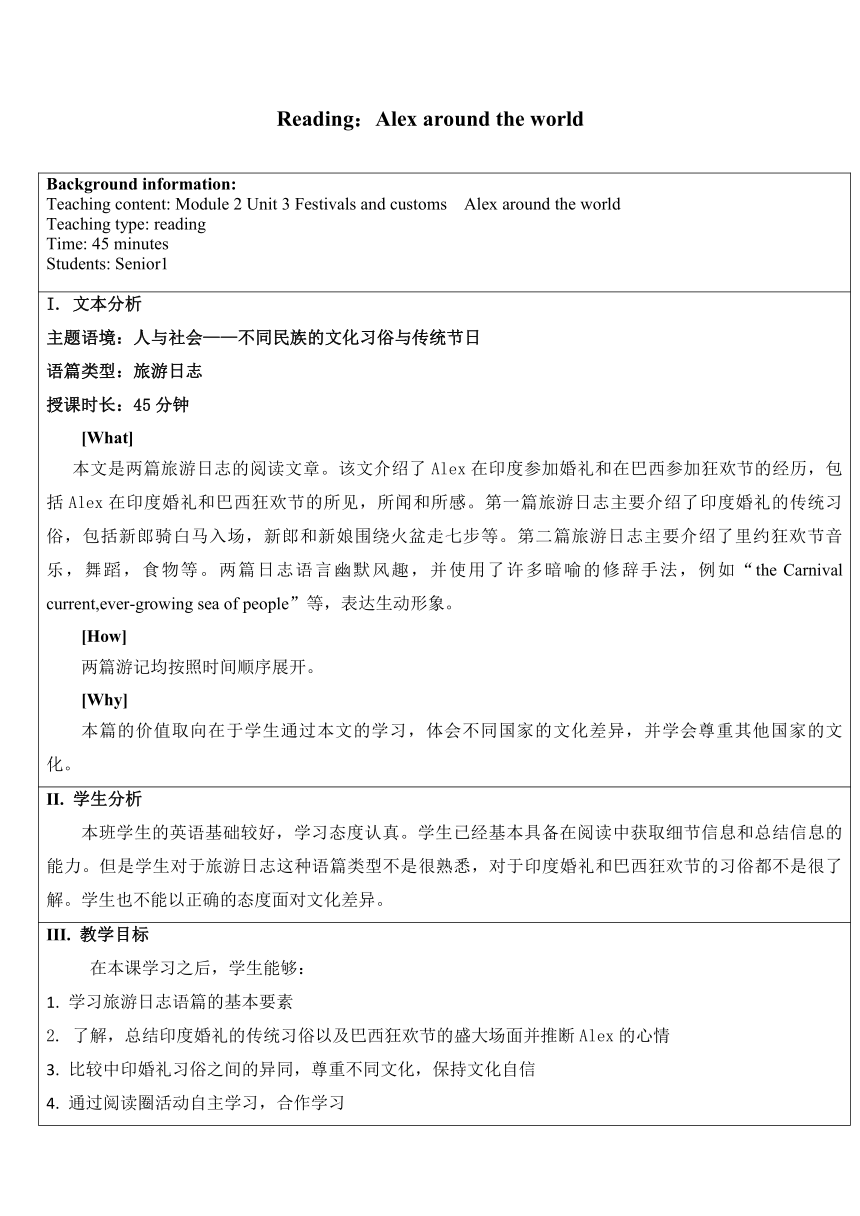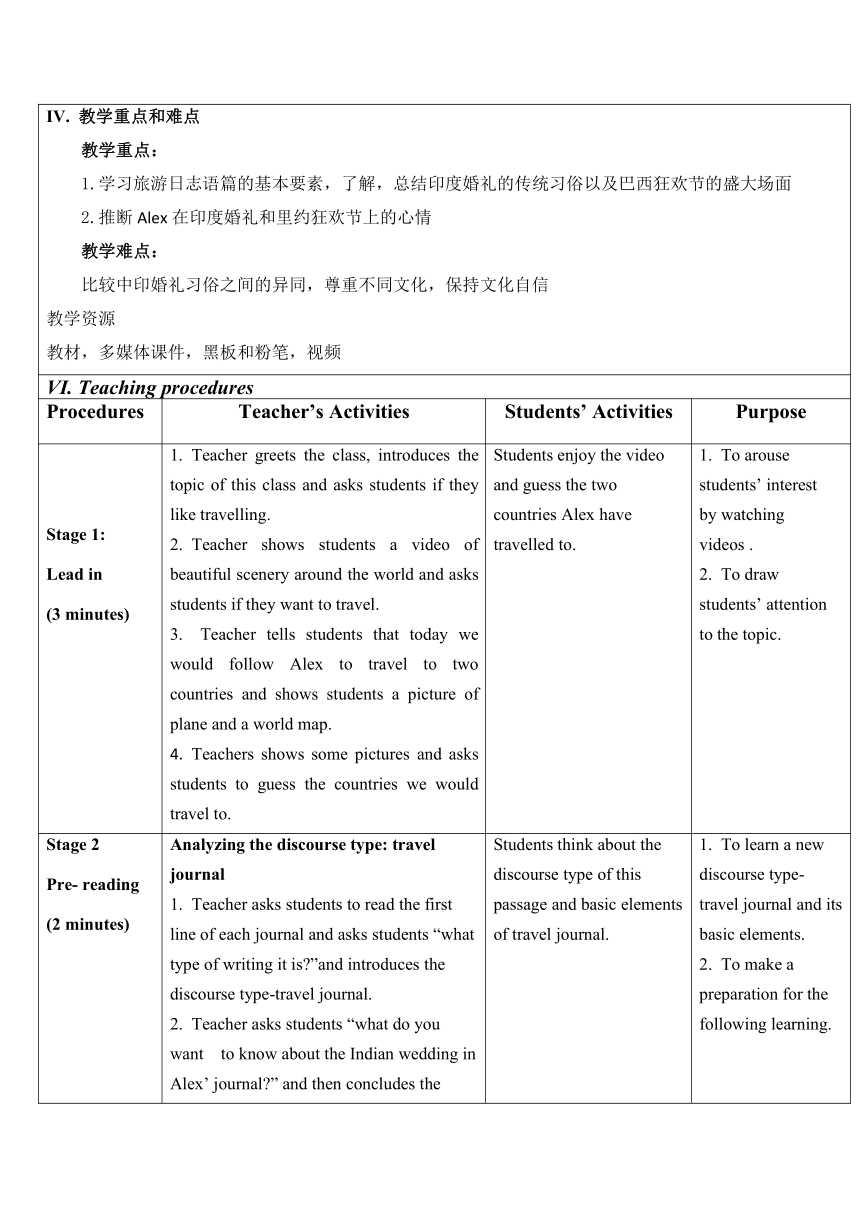牛津译林版(2019) 必修 第二册 Unit 3 Festivals and customs Reading 教学设计
文档属性
| 名称 | 牛津译林版(2019) 必修 第二册 Unit 3 Festivals and customs Reading 教学设计 |

|
|
| 格式 | docx | ||
| 文件大小 | 60.7KB | ||
| 资源类型 | 教案 | ||
| 版本资源 | 牛津译林版(2019) | ||
| 科目 | 英语 | ||
| 更新时间 | 2024-03-14 20:27:57 | ||
图片预览


文档简介
Reading:Alex around the world
Background information: Teaching content: Module 2 Unit 3 Festivals and customs Alex around the world Teaching type: reading Time: 45 minutes Students: Senior1
文本分析 主题语境:人与社会——不同民族的文化习俗与传统节日 语篇类型:旅游日志 授课时长:45分钟 [What] 本文是两篇旅游日志的阅读文章。该文介绍了Alex在印度参加婚礼和在巴西参加狂欢节的经历,包括Alex在印度婚礼和巴西狂欢节的所见,所闻和所感。第一篇旅游日志主要介绍了印度婚礼的传统习俗,包括新郎骑白马入场,新郎和新娘围绕火盆走七步等。第二篇旅游日志主要介绍了里约狂欢节音乐,舞蹈,食物等。两篇日志语言幽默风趣,并使用了许多暗喻的修辞手法,例如“the Carnival current,ever-growing sea of people”等,表达生动形象。 [How] 两篇游记均按照时间顺序展开。 [Why] 本篇的价值取向在于学生通过本文的学习,体会不同国家的文化差异,并学会尊重其他国家的文化。
II. 学生分析 本班学生的英语基础较好,学习态度认真。学生已经基本具备在阅读中获取细节信息和总结信息的能力。但是学生对于旅游日志这种语篇类型不是很熟悉,对于印度婚礼和巴西狂欢节的习俗都不是很了解。学生也不能以正确的态度面对文化差异。
III. 教学目标 在本课学习之后,学生能够: 学习旅游日志语篇的基本要素 了解,总结印度婚礼的传统习俗以及巴西狂欢节的盛大场面并推断Alex的心情 比较中印婚礼习俗之间的异同,尊重不同文化,保持文化自信 通过阅读圈活动自主学习,合作学习
IV. 教学重点和难点 教学重点: 1.学习旅游日志语篇的基本要素,了解,总结印度婚礼的传统习俗以及巴西狂欢节的盛大场面 2.推断Alex在印度婚礼和里约狂欢节上的心情 教学难点: 比较中印婚礼习俗之间的异同,尊重不同文化,保持文化自信 教学资源 教材,多媒体课件,黑板和粉笔,视频
VI. Teaching procedures
Procedures Teacher’s Activities Students’ Activities Purpose
Stage 1: Lead in (3 minutes) Teacher greets the class, introduces the topic of this class and asks students if they like travelling. Teacher shows students a video of beautiful scenery around the world and asks students if they want to travel. Teacher tells students that today we would follow Alex to travel to two countries and shows students a picture of plane and a world map. Teachers shows some pictures and asks students to guess the countries we would travel to. Students enjoy the video and guess the two countries Alex have travelled to. To arouse students’ interest by watching videos . To draw students’ attention to the topic.
Stage 2 Pre- reading (2 minutes) Analyzing the discourse type: travel journal Teacher asks students to read the first line of each journal and asks students “what type of writing it is ”and introduces the discourse type-travel journal. Teacher asks students “what do you want to know about the Indian wedding in Alex’ journal ” and then concludes the basic elements of travel journal: time, place, people, events and feeling. Students think about the discourse type of this passage and basic elements of travel journal. To learn a new discourse type- travel journal and its basic elements. To make a preparation for the following learning.
Stage 3: While—reading (25 minutes) Fast reading( An Indian wedding) 1.Teacher asks students to read the first journal and find out the time, place and people of the Indian wedding 2. Teacher asks students to read paragraph 3 and 4 and put the events at the Indian wedding in the correct order. 3. Teacher checks the answer and uses some photos to help students understand the traditional customs of Indian weddings. Read for Alex’s feelings (An Indian wedding) Teacher asks students to read the last sentence “Now I know I have two left feet... and both of them hurt.” and think about two questions What does “I have two left feet” mean What does Alex imply Reading circle ( Rio Carnival) Teacher divides students into groups of 4 and shows them a table about analysis roles in each group and analysis focus and asks students to pick their role autonomously. Teacher invites students to share their opinions in class and sums up their ideas and supplements some information. Teacher guides students to appreciate the language and figure of speech. Students read the travel journals carefully to sum up the time, place, people events at the Indian wedding. Students infer Alex’ feeling by reading between the lines. Students work in groups to summarize and analyze the place, people, date and events in Rio Carnival, Students analyzes Alex’s feeling at the Rio Carnival and appreciate the vivid language. To learn the customs of Indian weddings and Rio Carnival. To cultivate students ability of reading between the lines. To develop students’ autonomous learning and cooperative learning ability by doing the reading circle task.
Stage 4: Post-reading (10 minutes) Discussion: Differences and similarities between Chinese weddings and Indian wedding Teacher asks students to think about customs at Chinese weddings and shows them some photos about customs at Chinese weddings. Teacher divides students into groups of 4 to discuss the differences and similarities between Chinese wedding and Indian wedding Watch a video : Think about how should we view cultural differences and Chinese traditional culture Teacher shows students a video about wedding traditions around the world. Teacher asks students to think about how should we view cultural differences and what is the right attitude to our traditional culture. Teacher invites students to share their opinions and makes a conclusion. Teacher share students some brilliant cultural variety shows. Students think about customs at Chinese weddings and differences and similarities between Chinese weddings and Indian weddings. Students watch the video and express their opinions to cultural differences and traditional Chinese culture. To compare different cultural customs. To guide students to respect cultural differences and treat each culture equally. To guide students be confident in traditional Chinese culture.
Stage 5 Summary (3 minutes) Teacher guides students to summarize what we have leaned with the help of blackboard-writing. Students think about what they have learned and summarize with the help of blackboard-writing. To review the learning content of this lesson and help students form a good habit of reviewing regularly.
Homework (2 minutes) Watch a video to learn more about Brazilian Carnival. Write a small passage to introduce Brazilian Carnival in 200 words. Write down the homework. To consolidate what they have learned.
Optional activity: Watch a video to learn more about Brazilian Carnival Blackboard design: Unit 3 Festivals and customs Reading------Alex around the world Cultural difference
Background information: Teaching content: Module 2 Unit 3 Festivals and customs Alex around the world Teaching type: reading Time: 45 minutes Students: Senior1
文本分析 主题语境:人与社会——不同民族的文化习俗与传统节日 语篇类型:旅游日志 授课时长:45分钟 [What] 本文是两篇旅游日志的阅读文章。该文介绍了Alex在印度参加婚礼和在巴西参加狂欢节的经历,包括Alex在印度婚礼和巴西狂欢节的所见,所闻和所感。第一篇旅游日志主要介绍了印度婚礼的传统习俗,包括新郎骑白马入场,新郎和新娘围绕火盆走七步等。第二篇旅游日志主要介绍了里约狂欢节音乐,舞蹈,食物等。两篇日志语言幽默风趣,并使用了许多暗喻的修辞手法,例如“the Carnival current,ever-growing sea of people”等,表达生动形象。 [How] 两篇游记均按照时间顺序展开。 [Why] 本篇的价值取向在于学生通过本文的学习,体会不同国家的文化差异,并学会尊重其他国家的文化。
II. 学生分析 本班学生的英语基础较好,学习态度认真。学生已经基本具备在阅读中获取细节信息和总结信息的能力。但是学生对于旅游日志这种语篇类型不是很熟悉,对于印度婚礼和巴西狂欢节的习俗都不是很了解。学生也不能以正确的态度面对文化差异。
III. 教学目标 在本课学习之后,学生能够: 学习旅游日志语篇的基本要素 了解,总结印度婚礼的传统习俗以及巴西狂欢节的盛大场面并推断Alex的心情 比较中印婚礼习俗之间的异同,尊重不同文化,保持文化自信 通过阅读圈活动自主学习,合作学习
IV. 教学重点和难点 教学重点: 1.学习旅游日志语篇的基本要素,了解,总结印度婚礼的传统习俗以及巴西狂欢节的盛大场面 2.推断Alex在印度婚礼和里约狂欢节上的心情 教学难点: 比较中印婚礼习俗之间的异同,尊重不同文化,保持文化自信 教学资源 教材,多媒体课件,黑板和粉笔,视频
VI. Teaching procedures
Procedures Teacher’s Activities Students’ Activities Purpose
Stage 1: Lead in (3 minutes) Teacher greets the class, introduces the topic of this class and asks students if they like travelling. Teacher shows students a video of beautiful scenery around the world and asks students if they want to travel. Teacher tells students that today we would follow Alex to travel to two countries and shows students a picture of plane and a world map. Teachers shows some pictures and asks students to guess the countries we would travel to. Students enjoy the video and guess the two countries Alex have travelled to. To arouse students’ interest by watching videos . To draw students’ attention to the topic.
Stage 2 Pre- reading (2 minutes) Analyzing the discourse type: travel journal Teacher asks students to read the first line of each journal and asks students “what type of writing it is ”and introduces the discourse type-travel journal. Teacher asks students “what do you want to know about the Indian wedding in Alex’ journal ” and then concludes the basic elements of travel journal: time, place, people, events and feeling. Students think about the discourse type of this passage and basic elements of travel journal. To learn a new discourse type- travel journal and its basic elements. To make a preparation for the following learning.
Stage 3: While—reading (25 minutes) Fast reading( An Indian wedding) 1.Teacher asks students to read the first journal and find out the time, place and people of the Indian wedding 2. Teacher asks students to read paragraph 3 and 4 and put the events at the Indian wedding in the correct order. 3. Teacher checks the answer and uses some photos to help students understand the traditional customs of Indian weddings. Read for Alex’s feelings (An Indian wedding) Teacher asks students to read the last sentence “Now I know I have two left feet... and both of them hurt.” and think about two questions What does “I have two left feet” mean What does Alex imply Reading circle ( Rio Carnival) Teacher divides students into groups of 4 and shows them a table about analysis roles in each group and analysis focus and asks students to pick their role autonomously. Teacher invites students to share their opinions in class and sums up their ideas and supplements some information. Teacher guides students to appreciate the language and figure of speech. Students read the travel journals carefully to sum up the time, place, people events at the Indian wedding. Students infer Alex’ feeling by reading between the lines. Students work in groups to summarize and analyze the place, people, date and events in Rio Carnival, Students analyzes Alex’s feeling at the Rio Carnival and appreciate the vivid language. To learn the customs of Indian weddings and Rio Carnival. To cultivate students ability of reading between the lines. To develop students’ autonomous learning and cooperative learning ability by doing the reading circle task.
Stage 4: Post-reading (10 minutes) Discussion: Differences and similarities between Chinese weddings and Indian wedding Teacher asks students to think about customs at Chinese weddings and shows them some photos about customs at Chinese weddings. Teacher divides students into groups of 4 to discuss the differences and similarities between Chinese wedding and Indian wedding Watch a video : Think about how should we view cultural differences and Chinese traditional culture Teacher shows students a video about wedding traditions around the world. Teacher asks students to think about how should we view cultural differences and what is the right attitude to our traditional culture. Teacher invites students to share their opinions and makes a conclusion. Teacher share students some brilliant cultural variety shows. Students think about customs at Chinese weddings and differences and similarities between Chinese weddings and Indian weddings. Students watch the video and express their opinions to cultural differences and traditional Chinese culture. To compare different cultural customs. To guide students to respect cultural differences and treat each culture equally. To guide students be confident in traditional Chinese culture.
Stage 5 Summary (3 minutes) Teacher guides students to summarize what we have leaned with the help of blackboard-writing. Students think about what they have learned and summarize with the help of blackboard-writing. To review the learning content of this lesson and help students form a good habit of reviewing regularly.
Homework (2 minutes) Watch a video to learn more about Brazilian Carnival. Write a small passage to introduce Brazilian Carnival in 200 words. Write down the homework. To consolidate what they have learned.
Optional activity: Watch a video to learn more about Brazilian Carnival Blackboard design: Unit 3 Festivals and customs Reading------Alex around the world Cultural difference
